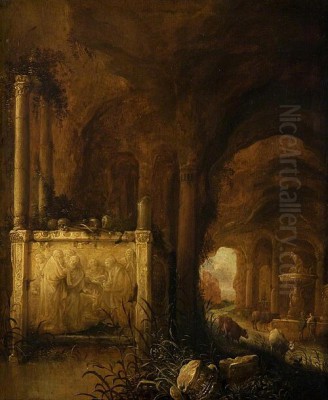
Abraham van Cuylenborch stands as a distinctive figure within the rich tapestry of Dutch Golden Age painting. Active during the mid-17th century, he dedicated his career primarily to the creation of evocative landscapes, often set within the mysterious confines of caves and grottos, populated by mythological figures and classical ruins. Though details of his life remain somewhat fragmented, his work offers a clear window into a specific Italianate tradition thriving in the city of Utrecht.
Sources provide slightly conflicting biographical details. While some suggest a birth year around 1610 and a possible origin in Hamburg before settling in Utrecht, other evidence points towards a birth date closer to 1620, specifically within Utrecht itself. His documented period of activity spans from 1639 until his death, which occurred in 1658. One source places his death in Paris, adding another layer to his geographical movements. Despite these ambiguities, it is certain that Utrecht was the central hub of his artistic life and development.
Early Life and Artistic Formation
Regardless of his exact birth year or location, Abraham van Cuylenborch established himself as an artist in Utrecht. The city was a vibrant center for painting, known particularly for its artists who had absorbed Italian influences. The most significant figure in Cuylenborch's artistic development appears to have been Cornelis van Poelenburch (c. 1594–1667), a leading master of the Dutch Italianate landscape style.
Evidence strongly suggests that Cuylenborch was either a direct student or a close follower of Poelenburch. Poelenburch himself had spent considerable time in Italy, particularly Florence and Rome, absorbing the lessons of Renaissance landscape painting and the works of artists like Adam Elsheimer. He returned to Utrecht bringing a style characterized by smooth finishes, idyllic Arcadian scenes, and mythological or biblical figures set in luminous landscapes, often featuring ruins. Poelenburch also worked in London between 1614 and 1616 and enjoyed significant success, even attracting attention from the French court, highlighting the international appeal of his style.
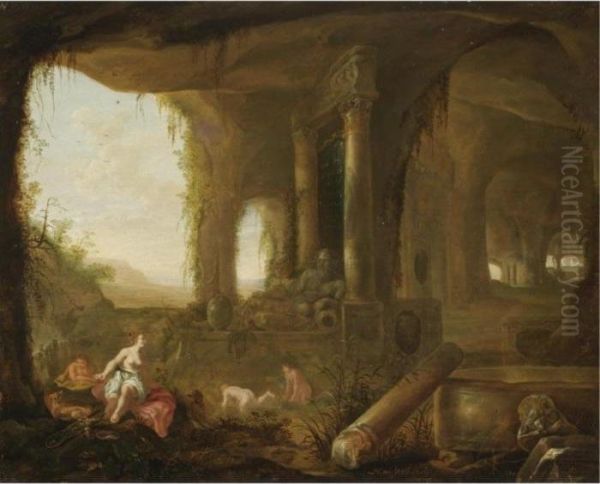
This connection to Poelenburch placed Cuylenborch firmly within the Utrecht school of Italianate landscape painters. While Poelenburch is considered the primary influence, some sources suggest that Cuylenborch might also have been impacted during his formative years by artists such as Dirck van Stoop, another Utrecht painter, though details of this connection are scarce.
Artistic Style and Thematic Focus
Abraham van Cuylenborch carved a niche for himself with a specific thematic and stylistic focus. His oeuvre is dominated by landscapes, but not the typical flat Dutch countryside. Instead, he specialized in depicting caves, grottos, and rocky outcrops, often dramatically lit and featuring openings revealing distant, brighter landscapes. These settings frequently incorporated classical ruins, evoking a sense of antiquity and Arcadian nostalgia.
Within these atmospheric settings, Cuylenborch placed small figures that gave narrative context to the scenes. Nude bathing nymphs are a recurring motif, often associated with mythological subjects like Diana and her attendants. He also painted biblical scenes, such as Samuel and the Elders or Solomon and his Daughters, where, characteristically, nude or semi-nude female figures often played central roles. Mythological themes beyond Diana included figures like Bacchus and his followers, or narratives such as Hercules rescuing Andromeda.
While clearly influenced by Cornelis van Poelenburch, Cuylenborch developed his own stylistic traits. Compared to his master, Cuylenborch's figures are often described as being more slender or elongated. Some art historians note that his rendering technique, particularly in the figures, could be slightly less refined than Poelenburch's smooth, enamel-like finish. His landscapes, particularly the rocky formations of his grottos, demonstrate a distinct interest in texture and dramatic light contrasts. The influence of another Utrecht Italianate painter, Jan Both (c. 1618–1652), known for his warmer, more golden light, has also been noted on Cuylenborch's style.
The Grotto Specialization
Cuylenborch's dedication to "grotto paintings" makes him a specialist in a subgenre that held particular appeal during the late 16th and early 17th centuries. The fascination with natural caves and artificial grottos, often associated with classical mythology (like the homes of nymphs or sibyls) or seen as places of mystery and transformation, was prevalent in European art and garden design.
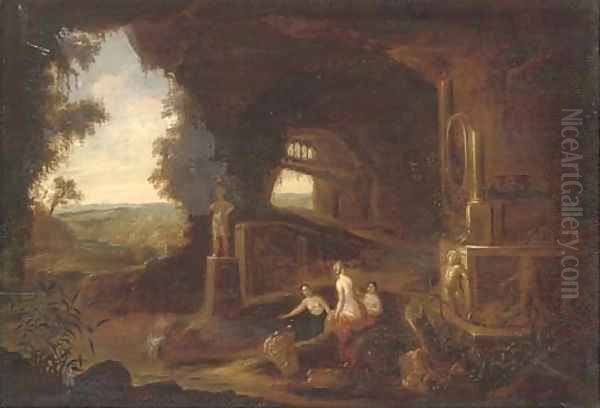
His focus on these subterranean or rocky enclosed spaces allowed for dramatic plays of light and shadow, contrasting the dark interiors with glimpses of sunlit exterior landscapes. This created a sense of depth and theatricality. The inclusion of ancient ruins within these settings further enhanced the feeling of a lost, idyllic past, aligning with the Arcadian themes popular among the Italianate painters.
The source material suggests that the popularity of depicting natural and artificial caves was inspired by artists active slightly earlier, such as Marsilio van der Mazen and Herman van Swanevelt (c. 1603–1655). Van Swanevelt, like Poelenburch and Both, spent significant time in Rome and was known for his classical landscapes. Cuylenborch's consistent exploration of the grotto theme solidified his reputation in this specific area and contributed significantly to the variety within Dutch landscape painting, moving beyond pastoral fields to explore more rugged, imaginative, and classically inspired terrains.
Connections and Contemporaries
Abraham van Cuylenborch operated within a network of artists centered around Utrecht and the Italianate style. His primary connection, as established, was with Cornelis van Poelenburch, likely as a student or follower. This placed him in the same artistic circle as other Poelenburch pupils.
One notable contemporary and fellow student of Poelenburch was Dirck van der Lisse (1607–1669). Van der Lisse is often considered one of Poelenburch's most accomplished pupils and also specialized in Italianate landscapes with mythological figures, sometimes featuring grotto scenes similar to Cuylenborch's. While the source text mentions Van der Lisse as a potential influence on Cuylenborch, or even possibly his teacher (though this is stated as unconfirmed and less likely than the Poelenburch connection), there is no concrete evidence of direct collaboration. Their shared training under Poelenburch and activity in Utrecht, however, clearly links them artistically.
Cuylenborch himself appears to have taken on students. The painter Dirk Sturchius is mentioned as having studied with him before traveling to England between 1637 and 1641, where he later found success. This indicates Cuylenborch's role in propagating the style.
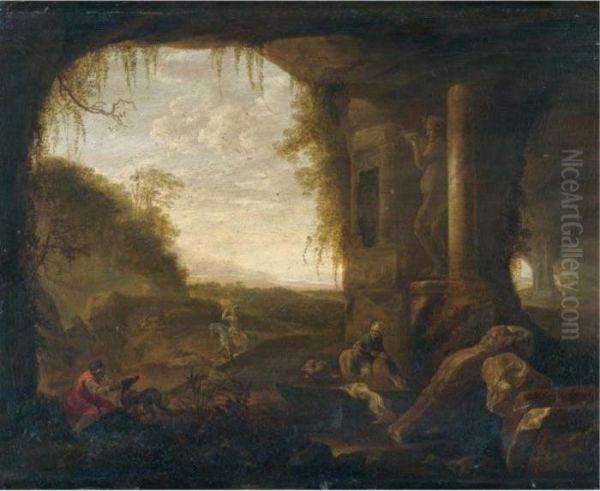
Furthermore, Cuylenborch's work exists within the broader context of Dutch landscape painting influenced by Italy. The aforementioned Jan Both was a key figure, influencing artists like Aelbert Cuyp (1620–1691) in the mid-1640s towards a more Italianate style. Since Both himself was influenced by Poelenburch, there's an indirect lineage connecting Cuylenborch's artistic milieu to major figures like Cuyp, highlighting the pervasive impact of the Italianate aesthetic. The artists explicitly mentioned in the source material connected to Cuylenborch's context are: Cornelis van Poelenburch, Dirck van Stoop, Jan Both, Marsilio van der Mazen, Herman van Swanevelt, Dirck van der Lisse, Dirk Sturchius, and Aelbert Cuyp.
Notable Works and Collections
Several key works by Abraham van Cuylenborch survive today, housed in major museum collections, showcasing his characteristic themes and style.
One prominent example is Grotto with Diana and her Nymphs. A version of this subject is held by the Mauritshuis Royal Picture Gallery in The Hague (the source text confusingly mentions Rijksmuseum parenthetically, but Mauritshuis fits the description and location). This painting exemplifies his typical composition: the goddess and her attendants bathing within a dark, rocky grotto, with light filtering in to illuminate the figures and parts of the cave interior.
Another painting titled Grotto with Diana and her Nymphs (I) resides in the collection of The Metropolitan Museum of Art in New York. The repetition of this theme underscores its importance in his output.
The Metropolitan Museum also holds his Bacchus and Nymphs in a Landscape, demonstrating his engagement with other mythological subjects popular within the Italianate tradition.
A work titled Hercules kills the sea monster to release Andromeda, also attributed to him and located at the Metropolitan Museum, is given a creation date of 1562 in the source material. This date is highly improbable given Cuylenborch's established active period (1639-1658) and likely represents an error in the source documentation, but it is listed as such.
Dated works help anchor his chronology, such as Landscape with Ancient Ruins from 1643, now in the Landesmuseum Hannover. This piece clearly displays his integration of classical architectural elements within a landscape setting, typical of the Italianate style. These representative works consistently demonstrate his focus on mythological or biblical narratives set within imaginative grottoes or landscapes featuring ancient ruins, executed in a style derived from Poelenburch but with his own distinct characteristics.
Later Life and Legacy
Abraham van Cuylenborch remained active as a painter in Utrecht throughout the 1640s and 1650s, with his documented activity ceasing around the time of his death in 1658. The possibility of his death occurring in Paris suggests potential travel later in his life, although Utrecht remained his primary base.
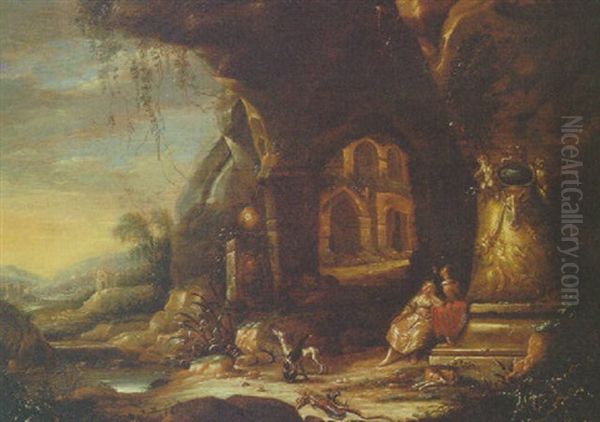
During his lifetime and shortly thereafter, his works gained recognition, particularly in the Netherlands and Germany. His specialized grotto paintings were appreciated as a unique contribution and attracted the interest of collectors. He successfully carved out a niche within the competitive Dutch art market of the 17th century.
Despite this recognition, comprehensive details about his life, personality, and artistic process remain relatively scarce compared to some of his more famous contemporaries. This lack of extensive documentation contributes to him being a somewhat enigmatic figure in art history.
Nevertheless, Abraham van Cuylenborch's legacy lies in his dedicated exploration of the Italianate landscape, particularly the grotto scene. As a follower of Cornelis van Poelenburch, he helped solidify and disseminate this style within Utrecht. His paintings, with their characteristic blend of naturalistic observation (in the rendering of rocks and light) and imaginative, classically inspired subject matter, represent an important facet of the Dutch Golden Age's engagement with international artistic trends, offering a contrast to the more commonly known depictions of the local Dutch environment. His work continues to be studied for its contribution to landscape painting and its representation of mythological and biblical themes through a distinctively Italianate Dutch lens.